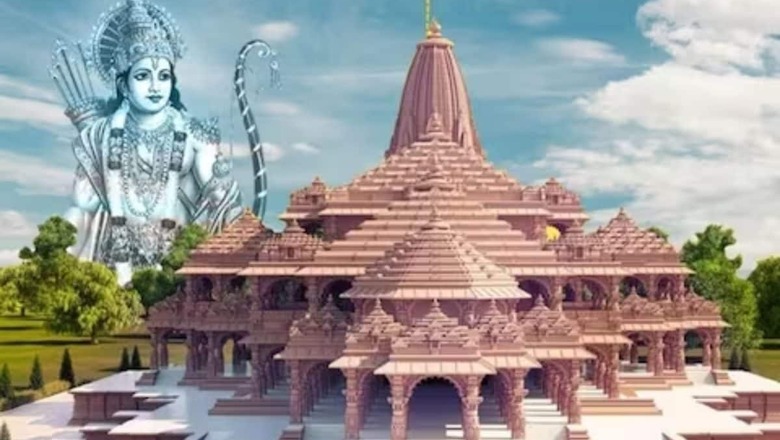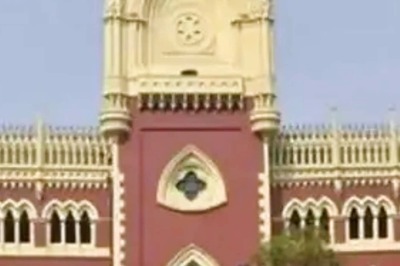
views
India is precisely 12 days away from the Pran Pratishtha (consecration) ceremony of Lord Ram in his new abode at Ayodhya. And the whole nation is already agog to the tune of ‘Ram Dhun’ and ‘Ram Aayenge, Aayenge, Aayenge’. Indubitably, on January 22, all trains, buses, cars, and planes will lead to Ayodhya and those left out will be glued to the TV sets either in their living rooms or community places. It will include me, a devout Ram bhakt. There has been no moment as big as this in my 65 years of life.
Nonetheless, this piece is not about the temple. That story is done and dusted, and the celebration has already begun. It is time for all Indians, irrespective of their faith, to join the once-in-centuries occasion. The central theme of this piece is about a very special, consequential great awakening moment of India. I will return to it a bit later. Before that, a caveat.
Secularly Secular
The caveat is, I am a devout Ram bhakt as well as secularly secular. And there is no contradiction here. An event in my professional life settles this. In the early 1990s, in the aftermath of the Harshad Mehta Securities Scam, when the arduous task to raise Rs 3400 crore to complete India’s signature Konkan Railway project fell on my tiny shoulders, for four long years, every day before hitting streets of India’s financial capital — Nariman Point and Cuffe Parade in Bombay (now Mumbai) — to beg and borrow (but not steal) Rs 5 crore daily (a lot then), I first paid obeisance to Mount Mary Church, Siddhivinayak Temple, Prabha Devi and Dargah of Pir Haji Ali Shah.
On a day when money eluded me, I would silently pray near Zoroastrian Heritage, the Bhikha Behram Well, Churchgate. And if money did not come for a week, I would take a bus to Shirdi Dham. I never returned empty-handed. And the Konkan Railway work never got stalled for the lack of money.
Lessons that Ayodhya Gives
I wrote ab initio, this piece is not about the temple. It is about the newfound confidence of Bharat, it is about a different lesson that Ayodhya gives, that must be celebrated across the nation from Kashmir to Kanyakumari. The central lesson is – the Ayodhya way. It is about a new ethos of infrastructure creation, a speed of execution not experienced in the country before, the one which should be the new mantra to make India a developed nation by 2047.
1535 Days
When on November 9, 2019, a five-judge bench of the Supreme Court of India comprising then Chief Justice Ranjan Gogoi and Justices SA Bobde, DY Chandrachud, Ashok Bhushan and Justice S. Abdul Nazeer pronounced the landmark judgement on Ayodhya to build a temple at Ram Janmbhoomi along with a mosque on a separate five-acre land, they decided on another first. It was a rare anonymous judgement of the apex court which decided not to have an author ascribed to the judgement.
That day was 1535 days away from January 22, 2024.
And neither yours truly nor possibly any Indian would have believed that in a mere 1535 days from the judgement day and 1265 days from the Bhumi Pujan day, despite the curse of Covid-19, there would be the consecration of Lord Ram in his new abode. And in parallel, the design of a grand mosque to be built on 40,000 square feet is getting ready, where 2,000 people would offer Namaz at a time, to be constructed by the Indo-Islamic Cultural Foundation Trust, at Ayodhya’s Dhannipur.
Unique Funding
The biggest lesson from Ayodhya is the unique financing of the temple’s construction. Though the exact amount collected differs, it is somewhere in the range of Rs 3000-5000 crore, uniquely ‘atmanirbhar’, being constructed without any recourse to the exchequer. Construction of the mosque which is facing a funds crunch apart from design delay issues too must be financed in the same way as a national endeavour.
The above financing model also provides a new pathway for the creation of nationally important infrastructure projects.
The Ayodhya Way
As one can see, the central message of Ayodhya is 24 hours a day, 7 days a week creation par excellence. It indeed is the central message for the creation of all infrastructure in India – the ‘Ayodhya’ way. On December 30, Prime Minister Modi dedicated (and laid the foundation stone of) infrastructure projects worth more than Rs 11,500 crore. Ayodhya, once the full temple (G+2) is completed in December 2024, is expected to bring three lakh domestic and international tourists per day.
Such is going to the impact of enormous religious and spiritual tourism that Lord Ram brings in his train at Ayodhya.
660 Days Marvel
Among the critical infrastructure projects dedicated to the nation by PM Modi on December 30 is a world-class brand-new Maharishi Valmiki International Airport, with a 2250-metre-long and 45-metre-wide runway, with the airport being constructed across an 821-acre area.
Phase I has been operationalised in less than 660 days from the date of the commencement of the construction in February 2022 and its 2250-metre-long runway will be able to handle bigger aircraft like Boeing 737, Airbus 319, and Airbus 320 in addition to smaller aircraft. In the second phase, the airport’s terminal building will be spread over 5 lakh square feet. Its runway will be increased from 2,200 metres to 3700 metres. This will help all international flights land directly in Ayodhya, including Boeing 787 and Boeing 777.
Ayodhya Dham is a Dream come True
The second infrastructure project inaugurated by PM Modi is the airport-style modern Ayodhya Dham Junction Railway Station, which has the largest concourse (set up on the first floor and spans 7200 square metres) in the country and a central dome inspired by Lord Ram’s crown. The new station building has a footprint of 140mx32.6m. An additional front porch of 140mx12m is also provided over the drop-off zone to protect the passengers from adverse weather conditions. It has separate entry and exit facilities for the passengers and is within walking distance from the temple complex.
The first phase of Rs 480 crore station projects has been developed at a cost exceeding Rs 240 crore. The ultramodern Ayodhya Dham station is a piece of excellence comprising a modern three-storey building equipped with state-of-the-art amenities, including 15 lifts, 12 escalators, food plazas, and childcare rooms and world-class passenger amenities, accessible and inclusive for all along with a green station building certification from the Indian Green Building Council (IGBC). Once the currently under-construction phase 2 of the station is complete, Ayodhya Dham will be handling 1,00,000 passengers per day.
While inaugurating the new station, PM Narendra Modi also inaugurated two new Amrit Bharat trains and six new Vande Bharat Trains in Ayodhya.
How fast the Ayodhya Dham Railway Station modernisation has been completed can be gauged by the fact that before that, in the past 20 years, the Indian Railways could modernise only two stations — Gandhi Nagar (EPC mode JV of Indian Railways and Gujarat State Government) and Rani Kamalapati Railway Station at Habib Ganj Madhya Pradesh (PPP). It will and must give the newfound confidence to Indian Railways to take the station modernisation plan across the country on a fast-track basis.
This is not all.
The Maharishi Valmiki International Airport and modernised Ayodhya Dham station (phase 2 of both to be completed in 2-3 years) are only the beginning. There is a slew of roads, tourism infrastructure, city beautification, hospitals and civic amenities projects either completed in record time or being completed on a fast-track basis.
New Ayodhya will not only be a smart city but also a solar city, the first in the country. According to the UP government, more than 200 projects worth Rs 30,923 crore are underway in Ayodhya at present, associated with 37 departments.
Just the Beginning
But the above is just the beginning. The dream gets bigger and will be completed over the next 10-20 years. The present annual influx of two crore pilgrims to Ayodhya is expected to soar exponentially, to above five crore by 2031 and reaching tenfold by 2047 with an incredible ‘Citizens to Tourists Proportion’ of 1:10.
The redevelopment of Ayodhya as per Master Plan 2031 will be completed over 10 years with an investment of over Rs 85,000 crore. The old Ayodhya, the core city of 31.5 square km will transform to 133 square km of planned city and 875 square km of Ayodhya Development Authority Area. Master Plan 2041 being crafted is much bigger.
Way forward to India @2047
“Ayodhya Way” gives a powerful message. It is time to mainstream the pace of the construction of Ayodhya’s infrastructure to the whole of India. It is time for the nation to take the solemn oath on the consecration day, what has happened in Ayodhya will be made to happen in the whole nation. And if the country takes this vow, Amrit Kaal may arrive earlier than 2047.
And India that is Bharat, thy time begins now.
The author is Multidisciplinary Thought Leader with Action Bias and India Based International Impact Consultant. He works as President Advisory Services of Consulting Company BARSYL. Views expressed in the above piece are personal and solely those of the author. They do not necessarily reflect News18’s views.




















Comments
0 comment